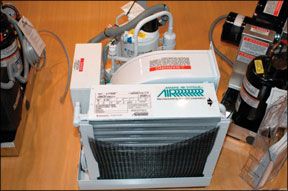I have an air-conditioning unit with more than 14,000 BTUs. Here in Florida, with a 38-foot boat, that just doesn’t hack it.
The unit’s been checked for efficiency by a technician. My prior boat (also 38 feet) had two units totaling over 20,000 BTUs. Those were effective, but that output is

Steve D’Antonio
288
enough to cool a small store ashore.
How are boat A/C BTUs determined? I suspect the temperature of coolant water is a major factor. Also, what is the effect when coolant water is suppressed by a clogged filter? Are they built to automatically shut down the compressor?
Al Wissner
Heat Seeker, Catalina 380
St. Petersburg, Fla.
Yes, water temperature and flow-rate can affect performance and most modern systems will shut down or at least beep a warning if the cooling circuit is clogged.
The BTU ratings for AC units are akin to flow rates for bilge pumps, they reflect an ideal scenario that simply does not exist.
Sizing an AC unit involves more than simply determining the volume of the area to be cooled and then plugging the number into an AC load formula. The vessel’s “insulation” must be taken into account.
For instance, is the hull cored? Core makes for excellent thermal insulation. Large hatches and windows add to the load put on the AC. Dark hulls—blue, black, green, and red—get considerably hotter than white or light-colored hulls, and this additional heating will often place a much higher demand on the AC system. Also, a system that may have been sized for New England’s cooler summers may be anemic in the sub-tropics of Florida.
The rough rule of thumb is 14-19 BTUs per cubic foot of space that is to be cooled. The higher figure would apply to warmer climates, less insulation, more windows, etc. Thus, your 14,000 BTU unit should be able to contend with approximately 1,000 cubic feet of cabin space. (I would guess your boat’s volume is larger than this.) Check your unit to determine whether it matches the cubic footage of the cabin, and remember the other load factors of color, tropics, windows, etc.
Other obstacles that can trip up a marine air-conditioning unit involve poor installation techniques. The ducting should be as short and straight as possible. Too many turns, particularly 90-degree turns, place added restriction on air flow, making it more difficult for the AC unit to absorb and remove heat from the vessel.
A test you can easily perform to measure the efficiency of the air-conditioning requires nothing more than a pocket thermometer. The cool air coming out of the register should be about 15 F or 20 F cooler than the air being drawn into the unit’s evaporator—measure this at the return air grill, and make sure the filter is clean while you are at it. Take the measurement after the system has been running for a half-hour or so and the boat is as cool as it gets. Finally, if the unit never cycles off, then it likely is either under-sized or it’s malfunctioning.
































